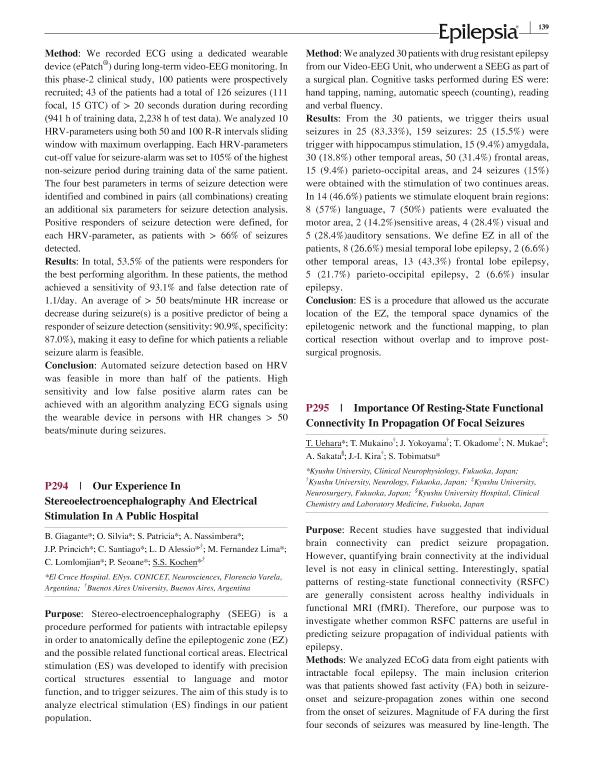Evento
Our experience in stereoelectroencephalography and electrical stimulation in a public hospital
Giagante, Brenda; Silvia, O.; Patricia, S.; Nasimbera, Alejandro ; Princich, Juan Pablo
; Princich, Juan Pablo ; Santiago, Cintia Cecilia
; Santiago, Cintia Cecilia ; D'Alessio, L. D.; Fernandez Lima, Monica Lorena
; D'Alessio, L. D.; Fernandez Lima, Monica Lorena ; Lomlomjian, C.; Seoane, P.; Kochen, Sara Silvia
; Lomlomjian, C.; Seoane, P.; Kochen, Sara Silvia
 ; Princich, Juan Pablo
; Princich, Juan Pablo ; Santiago, Cintia Cecilia
; Santiago, Cintia Cecilia ; D'Alessio, L. D.; Fernandez Lima, Monica Lorena
; D'Alessio, L. D.; Fernandez Lima, Monica Lorena ; Lomlomjian, C.; Seoane, P.; Kochen, Sara Silvia
; Lomlomjian, C.; Seoane, P.; Kochen, Sara Silvia
Tipo del evento:
Congreso
Nombre del evento:
33° Congreso Internacional de Epilepsia
Fecha del evento:
22/07/2019
Institución Organizadora:
International League Against Epilepsy;
Título de la revista:
Epilepsia
Editorial:
Wiley
ISSN:
1528-1167
Idioma:
Inglés
Clasificación temática:
Resumen
Purpose : Stereo- electroencephalography (SEEG) is a procedure performed for patients with intractable epilepsy in order to anatomically define the epileptogenic zone (EZ) and the possible related functional cortical areas. Electrical stimulation (ES) was developed to identify with precision cortical structures essential to language and motor function, and to trigger seizures. The aim of this study is to analyze electrical stimulation (ES) findings in our patient population. Method : We analyzed 30 patients with drug resistant epilepsy from our Video- EEG Unit, who underwent a SEEG as part of a surgical plan. Cognitive tasks performed during ES were: hand tapping, naming, automatic speech (counting), reading and verbal fluency. Results : From the 30 patients, we trigger theirs usual seizures in 25 (83.33%), 159 seizures: 25 (15.5%) were trigger with hippocampus stimulation, 15 (9.4%) amygdala, 30 (18.8%) other temporal areas, 50 (31.4%) frontal areas, 15 (9.4%) parieto- occipital areas, and 24 seizures (15%) were obtained with the stimulation of two continues areas. In 14 (46.6%) patients we stimulate eloquent brain regions: 8 (57%) language, 7 (50%) patients were evaluated the motor area, 2 (14.2%)sensitive areas, 4 (28.4%) visual and 5 (28.4%)auditory sensations. We define EZ in all of the patients, 8 (26.6%) mesial temporal lobe epilepsy, 2 (6.6%) other temporal areas, 13 (43.3%) frontal lobe epilepsy, 5 (21.7%) parieto- occipital epilepsy, 2 (6.6%) insular epilepsy. Conclusion : ES is a procedure that allowed us the accurate location of the EZ, the temporal space dynamics of the epiletogenic network and the functional mapping, to plan cortical resection without overlap and to improve postsurgical prognosis.
Palabras clave:
EPILAPSY
,
INMUNO
Archivos asociados
Licencia
Identificadores
Colecciones
Eventos(ENYS)
Eventos de UNIDAD EJECUTORA DE ESTUDIOS EN NEUROCIENCIAS Y SISTEMAS COMPLEJOS
Eventos de UNIDAD EJECUTORA DE ESTUDIOS EN NEUROCIENCIAS Y SISTEMAS COMPLEJOS
Citación
Our experience in stereoelectroencephalography and electrical stimulation in a public hospital; 33° Congreso Internacional de Epilepsia; Bangkok; Tailandia; 2019; 139-139
Compartir
Altmétricas



